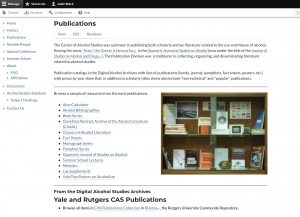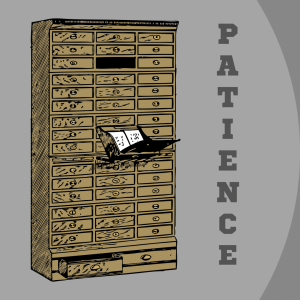 March means spring, and spring means spring break in academia, but work in the background never stops. The end of the month hallmarks the midpoint of my sabbatical dedicated to the Digital Alcohol Archive project: the perfect time to review, assess, regroup, and, learning from my own mistakes, adjust priorities for the second half. In a nutshell, project management 101.
March means spring, and spring means spring break in academia, but work in the background never stops. The end of the month hallmarks the midpoint of my sabbatical dedicated to the Digital Alcohol Archive project: the perfect time to review, assess, regroup, and, learning from my own mistakes, adjust priorities for the second half. In a nutshell, project management 101.
To begin with, as an instructor for the Digital Library Technologies course at SC&I, I used to preach the importance of preparedness and planning. What one can’t prepare and plan for is the complex structure of each institution, which will manifest itself in any given way at any time from miscommunication to rapidly changing practices and surefire future uncertainties. I am incredibly lucky to work on this project with individuals with whom we have been able to jump hurdles and clear roadblocks so far. But, it’s by no means a paved interstate highway to the digital heaven. The only thing I can do now is to minimize future potholes and keep the asphalt ready for the next Patchmaster.
With that said, focusing on sustainability will be my top priority in the second half. I sought advice from the experts (digital project manager, web developers, metadata librarian) how to improve the overall chances for the content to remain accessible, and as such, relevant. I believe halfway through I know where to concentrate efforts for the rest of the project.
Accomplishments
- Reaching the magic number 500 with items uploaded to RUcore felt like a milestone. Quality over quantity should be the guiding principle of digital projects, so whether it looks too many or too few, it should be noted that this number also indicates all the efforts invested in this project by me and my staff at the Alcohol Library.
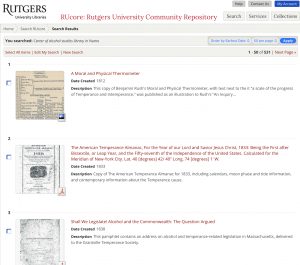
- Starting to add images to RUcore, in addition to pdfs so far, was a big step ahead in March. With the decision to create a fifth subcollection called Images, the workflow could be somewhat automated, but it’s still a more complicated process than uploading pdf documents. First, the image has to be archival quality, which means a high resolution tif format, when most of the images, some scanned as long ago as 20+ years, are small, low resolution jpegs. The option to rescan, for example, the 130+ images from the defunct Alcohol History Database, is virtually nonexistent: even if I managed to locate the source in Annex among the rare books, these are extremely brittle items. However, as great and rare resources related to Temperance, they are entitled to their spots in the Digital Alcohol Archive. Especially if I consider the work of previous librarians who selected, scanned, indexed, and described them. The solution was tricky: a global conversion by the digital curator from jpeg to tiff resulted decent quality images that can be preserved in RUcore and presented nicely too.
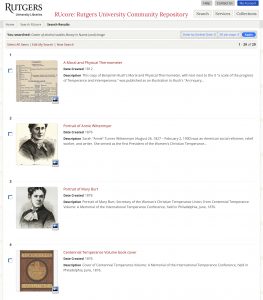 Significant improvements to the Drupal dev site include both structural and cosmetic changes. For longevity, the most important is trimming and consolidating pages such as the four subpages of notable people with their main page into a longish, Wikipedia-like page. It was suggested by the web developer, who will be the one to migrate the site, or who is considerate in advance for the next developer to do it. Although images on the site serve as illustrations and as such are stored locally on Drupal as jpegs, any tif uploaded to RUcore will come handy at migrations. I set up a spreadsheet to record these equivalents for future use. Cosmetic improvements include a nicer representation of the images via adding some padding and changing the fonts of the captions to the images in the CSS.
Significant improvements to the Drupal dev site include both structural and cosmetic changes. For longevity, the most important is trimming and consolidating pages such as the four subpages of notable people with their main page into a longish, Wikipedia-like page. It was suggested by the web developer, who will be the one to migrate the site, or who is considerate in advance for the next developer to do it. Although images on the site serve as illustrations and as such are stored locally on Drupal as jpegs, any tif uploaded to RUcore will come handy at migrations. I set up a spreadsheet to record these equivalents for future use. Cosmetic improvements include a nicer representation of the images via adding some padding and changing the fonts of the captions to the images in the CSS.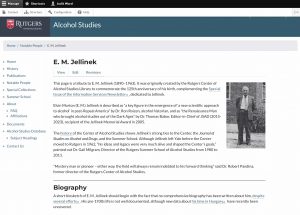
New discoveries
Improving the quality of pdfs scanned over 15 years ago has been my concern since starting to upload items to RUcore. The Adobe suit allows all kinds of manipulations, including changes to the orientation of the pages (and keeping them in the correct way), combining files (which is great for long documents scanned separately), or deleting and rearranging content if needed. The most useful feature, however, for a project like this, using documents previously scanned with equipment less high tech in the past, is the cropping function under the editing tool. This allows me to cut off the occasional dark edges (a constant issue with documents scanned by students who didn’t pay attention to scanning instructions), delete unneeded pages in documents scanned double sided, or even doctor up some older scans in many other ways.
Going live with the Drupal site seems to have more moving parts than expected. I am not sure I have all the details to list and worry about just yet. At this point the only thing I can say is that I am glad we started this conversation as early as March for a June launch!
Concerns
Feeling overwhelmed is part of any large project. Still, sometimes overanalyzing something, especially on my own, can lead to poor decisions or even worse, no decision at all, creating extra work down the road. What worked so far is asking for the input of others. “There’s more to it,” as one of my former coworkers would say, respecting both content and context unknown to us at that point. Then I make a decision and try how it looks in reality with a few samples. There’s always a chance to go back and tweak it, no matter what. If only I could remember how many times I re-edited certain items in RUcore after it didn’t look right. Oh well. I’m more concerned about the errors I missed.
Images or pdfs? When it comes to prioritizing, which format would make more sense for me to focus on? Researchers will definitely appreciate the textual content, among them many unique publications and documents not available anywhere else. Images, however, fall under the nice-to-have category in a research setting. The ones I still want to preserve, depending on quality, are as follows, all in the unique, available-only-from-us category.
- portraits of notable people in the field
- some Summer School group photos telling us about communities built at Yale and Rutgers
- photos of events and places of historical importance
- rare, Temperance-related images scanned decades ago that were part of the defunct Alcohol History Database
To do
Drupal pages – top priority (too many moving parts from other units)
- merge all Notable People pages like the Jellinek page
- see where else to trim and consolidate
- check and replace all links to DOI rather than RUcore URL or QuickSearch PURL
- check and delete external links, unless trusted and necessary
- finish spreadsheet with equivalent images: Drupal jpeg – RUcore tif
- scan select images as tif if necessary and possible to have matching jpeg-tif pairs
- show almost final version to web developers by mid-April
Digital files
- continue checking pdfs for quality and editing accordingly
- finish the list of items to be uploaded in the remaining three categories: Notable People, Special Collections, and Images
- start preparing spreadsheets of items to be uploaded in those three categories: research and write descriptions, etc.
- finalize images to be converted from jpeg to tif
- list image sources for Summer School images using Alumni News
Print material in Annex – lowest priority now, except where images needed in tif format
- scan available images in tif format (one envelope with 15 images)
- after finishing the reviews of all boxes, consolidating all newly discovered content under the same location seems to be in order, which ensures listing all Annex codes properly on the Drupal site
- the ten large boxes from the backroom might have some more relevant content, it’s worth exploring if there is time (note: lots of confidential material there)
Takeaway: Take what you can and leave the rest
Statistics
Number of files uploaded so far
- Omeka: 150 items (probably the final number)
- RUcore: 503 documents + 52 images
Pages and posts created so far
- Drupal: 74 pages (will decrease as pages are consolidated), 68 media items (will decrease as unused items ate deleted)
- WordPress: 49 pages, 68 posts, 375 images (no need to add more, Drupal will take over its place in a few months)
